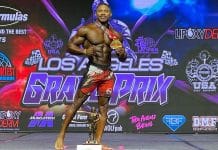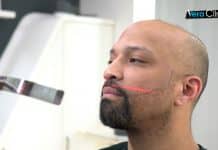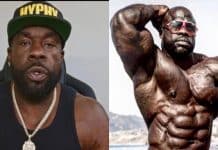Fred “Biggie” Smalls details the key to building muscle mass without gaining too much fat.
Beyond being a pro bodybuilder, Fred “Biggie” Smalls is also a tried and true trainer who has helped hundreds of clients and bodybuilders improve their physique. For those looking to build muscle mass, and especially for competitive bodybuilders, bulking is key to putting on size. But there is a delicate balance of building muscle versus gaining fat and knowing just how to do it effectively can make or break your entire process. In our latest GI Exclusive interview, Fred “Biggie” Smalls shares key insight into how to bulk without gaining too much fat.
Bulking and cutting are normal parts of a bodybuilding cycle. While not all competitors do it, it’s fairly common to have a bulking phase to gain size followed by a cutting phase to bring it down to sharp conditioning. Of course, that doesn’t mean you can eat whatever you want during the bulking phase. The more fat that’s built over muscle, the harder cutting later becomes. Finding this balance is key in working for your overall benefit when it comes to both bulking up and getting cut.
During our video conversation with Fred “Biggie” Smalls, we asked him to share key tips on how best to bulk up and build muscle without gaining too much fat. According to Smalls, it’s all about the frequency of which you eat clean versus dirty foods.
Successful bulking is directly tied to metabolism and also hunger. Depending on the kinds of food you eat, it will affect both. If you eat heavy, dirty food, you’ll find yourself full for much longer than when you eat clean meals. The problem is, if you eat too often, you will slow down your metabolism. This causes your body to hold on to stored fat longer. In short, this is not what you want as an aspiring or competitive bodybuilder.
Metabolism
That’s why Fred Smalls suggests finding a way to time out and balance a diet mixed with clean and dirty foods. Find the right balance and you will avoid overeating and slowing down your metabolism. Of course, if you eat too much dirty food, you’ll store more fat via the nutritional value of the food.
Your metabolism is one of the major parts of your body as it provides for energy to be used throughout the day and with your workouts. While some of us have slower metabolisms, there are ways to really boost it up to start seeing results, especially with your diet. Changes in your diet and proper exercise are key in getting a slow metabolism to start working for your benefit.
Adding spicy foods to your diet is a great way to increase your body temperature and start the thermogenesis process. Spicy foods, contain capsaicin, which is a key ingredient in boosting your metabolism and although the effects are temporary, getting the thermogenesis process to begin is key in helping to break down body fat (1). Green tea and coffee are also great ways to get a healthy amount of caffeine for increased energy while also working to free up fatty acids to convert into energy to aid in fat loss and a solid metabolic boost (2).
Carb Cycling
Carb cycling is a solid way to drop body fat and get more muscle, but requires strict attention. Since your body needs carbs to fully operate (3), carb cycling works to go back and forth between days of high carbs and low carbs, with even some no carb days sprinkled in. Smalls talks about an example carb cycle regimen of three days with low carbs, two days of moderate carbs, and one day of high carbs, but made it clear that it is hard to plan out. It is best to go with how the body looks and feels in order to have an accurate carb cycling process take place.
Cardio
When it comes to cardio, the debate lies in when to do it. While cardio is the same during any time of the day, since your calories in and out are much the same, when it comes to fasted cardio, Smalls encourages to do this in the morning. Fasted cardio is when you do cardiovascular training when the digestive system is done processing food. This will help burn more fat since you rely on stored energy to power your workout. Smalls feels doing this in the morning really works for your overall benefit.
Other forms of cardio like running and high-intensity interval training are also great for bodybuilders. High-intensity interval training requires short bursts with equal to more time of rest and really benefits your aerobic and anaerobic endurance (4). The best part is, you get the benefits of cardio while also working to keep on that lean muscle, so despite the reputation that bodybuilders should not do this, a great HIIT training session will not only boost your metabolism but also work for your weight loss and strength building goals.
Fred “Biggie” Smalls Workout Series
As part of our workout series with Smalls, he walks us through not only a great complete workout, but also separate workouts for all muscle groups, both upper body and lower body. With helpful hints and tips from this pro bodybuilder, his exercises and advice are amazing for those looking to get a great pump and build solid muscle, while also promoting weight loss and overall physical health.
Check out our Train Big with Fred Smalls workout series here.
Wrap Up
Each body is different – but Fred Smalls shares some of his suggestions in the video to get you on the right track. Starting with Smalls’ suggestions and adjusting to match your specific genetics is the best way to start improving your bulking and start making even bigger gains when it comes to muscle.
During our conversation, Fred “Biggie” Smalls dives into carb cycling and his tactics with cardio which are great tips for those wondering about the benefits surrounding cardio and bodybuilding. If you’re looking to learn not only about bulking but effective cutting techniques as well, this video is the perfect guide towards changing up your routine and improving your overall physique.
You can check out Fred “Biggie” Smalls full comments in the GI Exclusive interview segment above.
Let us know what you think in the comments below. Also, be sure to follow Generation Iron on Facebook, Twitter, and Instagram.
References
- Gregersen, N. T.; Belza, A.; Jensen, M. G.; Ritz, C.; Bitz, C.; Hels, O.; Frandsen, E.; Mela, D. J.; Astrup, A. (2013). “Acute effects of mustard, horseradish, black pepper and ginger on energy expenditure, appetite, ad libitum energy intake and energy balance in human subjects”. (source)
- Acheson, K. J.; Zahorska-Markiewicz, B.; Pittet, P.; Anantharaman, K.; Jequier, E. (1980). “Caffeine and coffee: their influence on metabolic rate and substrate utilization in normal weight and obese individuals”. (source)
- Slavin, Joanne; Carlson, Justin (2014). “Carbohydrates.” (source)
- Khalafi, Mousa; Symonds, Michael E. (2020). “The impact of high-intensity interval training on inflammatory markers in metabolic disorders: A meta-analysis”. (source)





















